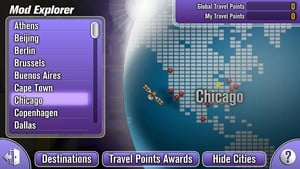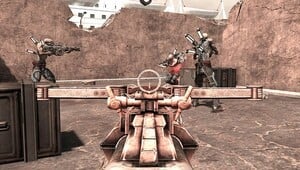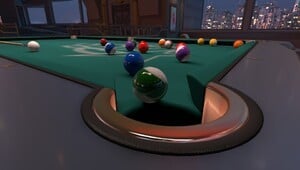
Online multiplayer has become a key component of gaming over the past ten years. Social platforms such as PlayStation Network have paved the way for connected experiences impossible on systems of old, and driven emerging brands such as Call of Duty to the top of the charts. And yet, while those experiences have thrived on static platforms like PS3, handhelds have struggled to tempt the same rising market. But is that a fault of ill-equipped hardware, or simply a discrepancy between the expectations of the two markets?
Despite its just-pocketable size, much has been made about Vita’s ability to operate like a console. In many ways, Sony’s shiny new handheld accentuates the infrastructural strides the platform holder has made since the PS3 released in 2006. The system is a portal of connectivity, allowing you to stay in touch with friends and, fairly easily, meet new ones through the system’s location-based networking system, Near. But while Vita is an undeniably equipped social platform, does it need to be inspired by its home console counterparts when it comes to online experiences?
The backlash ModNation Racers: Road Trip faced when Sony casually revealed that the title would ship without online multiplayer was unprecedented. Consumer interest in the title – which originally presented itself as one of the bright stars of Vita’s already-sparkling launch line up – took a severe nosedive, and it’s still looked upon as the tainted misstep in an otherwise stellar launch offering. The omission was a commercial oversight — that much cannot be denied — but beyond the clamouring and conversation for a mode that does not exist, did developer Sony San Diego actually invest its resources into the right areas?

Road Trip may not include online multiplayer in the traditional sense, but it has a richer offering of connected components that have largely gone overlooked amidst the demands for an infrastructure suite. Tying into the game’s titular activity, the Mod Explorer lavishes you (and the community) with unlockable in-game goods for taking the game out and about with you and registering your travels as you play. Travel Points accumulate on an individual and community basis, rewarding players with new objects and stickers which can be used in the game’s creation toolset. Similarly, checking into popular cities rewards you with a collection of themed prizes — once the community reaches a quota of check-ins at a specific location, all players are presented with an additional in-game item.
And the location-based implementation doesn’t end there. Leaderboards are closely connected to GPS data, allowing you to create arcade-like custom events based on where you are (school, work or home). Other competitors checking in to the location can compete against the leaderboard, creating a personal multiplayer environment through more suitable asynchronous hooks.
It’s clear from the sheer amount of work that was put into Road Trip’s online offering that Sony San Diego didn’t expect pre-release conversation to be fixated on the title’s lack of traditional head-to-head. And while it’s certainly true that the developer could have implemented an infrastructure component on top of its more innovative options, it’s unclear what advantage that would give the game beyond sating the backlash of vocal fans. Ultimately, Road Trip offers an online experience much more befitting of the platform.

Contrast it against another Vita launch title, WipEout 2048, and the differences are stark. While still innovative – through its unique progression system – Studio Liverpool’s futuristic racer opts for a much more static multiplayer component. Indeed, unlike Sony San Diego’s meta offering, WipEout 2048 demands a good internet connection to power its online campaign. It’s a feature that, while functionally sound, is inaccessible when the Vita is out and about.
Resistance: Burning Skies faces a similar dilemma. Its recently revealed multiplayer component consists of a competent deathmatch experience running on the Vita’s five-inch screen. But again, while it’s an unprecedented inclusion for a portable exclusive, is it an ill-suited one? Just like WipEout 2048, Burning Skies’ offering demands a strong Internet connection, limiting play to static (presumably indoor) locations. It’s far from the portable ideal that Vita's intended to represent.
In fact, Burning Skies’ most intriguing multiplayer asset comes through its implementation of Near. By taking the system and about you’ll be able to earn bonuses by infecting (or rallying) other consoles. It’s an interesting inclusion that plays to the system’s strengths, rather than limits its portability.
And yet, other examples prove that there’s no reason for Vita to compromise between competition and portability. Launch titles Hustle Kings and Top Darts manage to provide competitive experiences that work over 3G without the immediacy of a direct internet connection. Sure, the nature of both titles appeals to the slower pace of play, but there’s no reason that, with thought, games like Resistance: Burning Skies couldn’t offer a similarly competitive multiplayer experience that’s playable on-the-go. A fleshed out version of Global Resistance tantalisingly springs to mind.

But, considering the backlash aimed at ModNation Racers’ feature set, it’s becoming increasingly vague what gamers actually want from online multiplayer on Vita. Squandering the platform’s portability seems like a misstep, but the brunt of the conversation appears to be fixated on the idea of more traditional experiences contained within a smaller shell. There’s no reason the system can’t do both, of course, but spreading resources means neither direction is likely to get the thought and attention it deserves.
As such it’s up to the Vita’s early adopters to define the platform’s maturation. The experiences players gravitate towards now will help to decide the course of future releases. The question is: do you want traditional console multiplayer fare on a small screen, or do you want developers to take advantage of the system’s unprecedented connectivity and craft something fitting and fresh?





Comments 27
Sony has made such a big deal on how the vita is like a portable home console that it's no wonder people want the full console experience from it. For me, yes I absolutely want infrastructure multiplayer included in games like ModNation and Burning Skies, because I have some good friends who I would like to play with, and right now the Vita games don't even compare to several PSP titles that had good online modes.
I honestly don't mind of developers try something different for online play for the Vita, but not doing anything seems almost lazy seeing how all of Sony's commercials portray a sense of connectivity to other players.
Yes. It does. IMO, the PS Vita is less a "portable" console and more a "personal" console. Sure I can take the Vita outside my house, but I don't most of the time. Instead I play in my house...in any room I want to...I don't have to sit in my living room and play on my big screen TV. And I can play whenever the TV is being used by other family members.
@butcherknife exactly. I never play my Vita or 3DS outside of the house unless I'm on vacation. Modnation leaving out multiplayer is mind-boggling. It's like if Nintendo released Mario Kart 7 w/o multiplayer. I think they were rushed or something.
For the record I do want multiplayer. And I hope to see lots of Vita PSN games in the future along the lines of Fat Princess and Might & Magic and those sorts of addictive multiplayer games.
@Azikira Out of pure curiosity, what were your favourite multiplayer PSP titles?
They can't do Call of Duty or Monster Hunter on Vita without online multiplayer. And while I'd still buy it without online multiplayer, LittleBigPlanet should definitely have it as well.
I also think an MMO would be right at home on Vita. What's the point of having a 3G model if you have nothing to show for it?
Question is, do you really need the Vita??? Lol
@Marcus09 Yes, I really need the Vita. Best portable/"personal" system ever, by miles, imho.
Lack of multiplayer was the single determining reason I returned Modnation Racers:Road Trip. If MK7 can do it, there is no reason why MR:RT shouldn't have been able to as well. I don't require multiplayer over 3G (despite owning a 3G model), but I do think the Vita needs a robust multiplayer system in its titles for it to succeed.
@get2sammyb: I really enjoyed the Star Wars Battlefront titles and Resistance as far as competitive shooters go, and though it was a pain in the butt to set up, I really enjoyed Monster Hunter Freedom Unite even though you had to be chained to a PS3.
Yes. As people have said, several games that would boost Vita sales by a ton would only work with online.
@Marcus09
@butcherknife You have ripped the thought that has been bouncing around my subconscious for months now and wouldn't release. Vita feel exactly like a "personal console" and that's exactly why I love it so much.
I'm on the side of the fence that agrees that Vita has to bring true infrastructure online gaming into its games for it to truly gain mass market appeal. Having a "personal console" that can bring the same online experience to the palm of my hands, while not forcing me to seclude myself to another room and/or tie up the main television in my home, is absolutely wonderful and was the main selling point of Vita for me.
If Activision does it right, I can only imagine the firestorm of Vita sales that will take place if Activision brings an equal console experience to the upcoming CoD for Vita. When all the Dad's find out they can sit right by their kids watching cartoons and get their CoD on with their friends online — when they're now only getting the chance to do this an hour or two a week now — they'll be working overtime with a grin from ear to ear, to raise the funds to purchase Vita. If developed and marketed correctly, Vita will explode like a shell from an AC-130 when Call of Duty lands on it!
With that said, bringing offline and 3G functions to the games is actually quite easy, and can coincide with the infrastructure online multiplayer components. MotorStorm RC has a fantastic offline multiplayer option, but it could easily have a full online multiplayer too. Call of Duty can feature its full offerings, while bringing the Spec Ops Mode back, and uploading times/stats via 3G, etc. It can work both ways, and that's exactly what I want to see happen going forward.
@Slapshot
You are dead on. If my wife is watching the tv or playing animal crossing city folk and I want to be playing a full blown console game in portable format sony is definately catering to me. Now I have more than just hour to play with my friends on nights and weekends after work. Nintendo seems to have figured this out with the wii u via marketing research and focus groups. the average age of a gamer is 40 years old. The people who grew up with videogames and time to play them cannot enjoy their hobby as much as they use to due to time/family commitments. I will probably get lambasted by saying this but I traded in my PS3 and all games last friday. I loved the system (except for constant installs and updates) but I very very rarely got to play it. I can hop on my vita at almost anytime and play. I know there will be somebody who will say I could have used the remote play feature when it becomes available but I am not going to sit around and hold my breath waiting on that..it is a great idea but I think sony knows it would canabalize their sales on games...so i do not see them doing this update. If they do then oh well I have $500+ worth of trade in credit now to just purchase upcoming vita games with on day one. that is a risk I am willing to take. I also believe that the reason PC gaming has become so popular is due to the fact that most people who want to play but not take up the tv can just hop on their laptop and play in any room. I never considered Pc gaming until I got married and then I discovered that it great because I could play anytime, introduced me to new franchises/genres, and it was extremely cheap. It is an interesting time in the industry right now and the vita is on the right track.
As several others have already mentioned, Road Trip needed online if only b/c Mario Kart 7 had online. The 3DS really seems like a toy to me, and the Vita a far superior system, and you just can't allow yourself to look bad COMPARED TO THE COMPETITION when you are releasing a new product. The 3DS has Heroes of Ruin coming out soon w/ online multplayer. If I'm Sony I'm making online multiplayer a requirement for Vita games where it seems a natural fit. That's one area Sony should never be behind Nintendo.
@Zergling Glad you're enjoying Vita! I can't say that I would get rid of my PS3, but I will say that I've barely touched it since I've gotten my Vita. I've been so pleased with the launch titles so far, and Disgaea 3 is making sure that I'll be playing my Vita for... well... over 100 Million Hours!
@rjejr Don't forget that Sony has Warrior's Lair, which was formerly known as Lair, that'll be fully utilizing transfarring.
@Slapshot
*Formerly known as Ruin not Lair
Yes vita needs online multiplayer and also games
Vita should get more online games tht would be pretty cool! Btw people the PS4 sepcs got leaked! Here is a picture of it. http://www.picvalley.net/v.php?p=u/2564/66019497913364665701335371811EYYTYMYO6t5DKeUrNGxF.JPG
Does this picture look legit?
@magi and @savino
No we don't need Vita. It's not even portable with its bulk screen and prone to fall off your hands. I had the psp and even that wasn't portable as the ds or 3ds are.
My replacement for the Vita is not the 3ds, no, it's the PS3. I can carry it around the house max. Whereas I can with the 3ds. Portable gaming are not about graphics, it's about gaming on the go where you can have fun with a game like, yes, Mario and Zelda... It's not like I'm on a bus and I'll say: yeah let me finish this half hour long Uncharted mission.
Look at the sales stats and then tell me "it's the best portable console".
In Japan, its native country, apparently, it's the worst.
Maybe it's a matter of taste as well. I've got my Ps3 and Nintendo portables and that's the way, in my opinion, it should be.
@Qeuix I'm going to say it's not legit.
@Marcus09 Of course it's your opinion, and I respect that, but I think you're being a bit narrow minded. If your main issue is the compatibility of games for the format, then you're missing a lot. The likes of StarDust, Escape Plan and Mutant Blobs Attack are all perfectly pick-up and play. I'd argue Uncharted is no less pick-up and play that Zelda — the developer did a good job of making chapters short in that game to make it suitable to the portable format.
Also, sales are never necessarily indicative of a product's quality. There are a number of factors that are keeping the Vita off the top of the charts — and it has nothing to do with quality of the system itself.
@Marcus09 Define "we". If it's you and a frog in your pocket, then I concede that "we" don't need a Vita. If you're lumping in the rest of everyone with "we", then you're dead-wrong. "I" need a Vita. I have a PS3. I have a 3DS too. Neither replace the Vita, which I have never dropped by the way (lol?). Portable game play, for me, is about the total package and while that certainly and unequivocally includes game play and "gaming on the go", it also includes a stellar graphical experience as well as other things that the Vita brings to the table (dual sticks especially).
Also, "best portable console", as you stated, is not entirely synonymous with "best selling portable console".
If i had a vita i would expect to have some online multiplayer.
@Zergling I'm giving myself the Facepalm for that one!
Vita sales are slow, it's a fact, but what's happening with Vita is exactly what we saw with 3DS. It's sales numbers will climb with its software releases. Once the Japanese developers land a few quirky Japan-only titles that appeal to their taste, Vita sales will takeoff there too.
@Slapshot I agree, this is the only reason i havent purchased one, im waiting for enough quality software to justify my purchase and have enough games that i enjoy too.
Does it NEED them to survive? Probably not. Should it have them anyway? Definitely. Sony hyped Vita as a home console in the palm of your hands - the omission of online play on games that should by all means have it (MNR, I'm looking at you), makes you question Sony's words.
I'm reserving judgement until I see how lag-free and polished Resistance: Burning Skies multiplayer component is. 4v4 isn't much, and if Vita really is as capable as Sony say, it should easily be able to handle even bigger, more PS3- like games.
As I said previously, it's my opinion, and as I respect yours, I will not do the same mistake twice that I did with the psp. Vita games are very similar with ps3 games, that is why I wanted something different than ps3 like the 3ds.
I am a big fan of ps as I said before. I preordered both the ps2 and ps3 when they came out 10 and 5 years ago respectively. Besides, up until now, games on ps3 are better rated than psv; one major example is the Uncharted series that I adored on ps3 that I considered them games that make all other games worthless. I dunno, I usually couldn't take my psp with me since it was bulky. It's not the case with my ds and 3ds. So if I'm keeping my Vita at home, you guessed it, I can have the PS3.
Nice talking to you guys. It's been fun.
Oh and one more thing, it also felt like an iPad, specially with the touch controls.
@Marcus09 If we all thought alike the world would be quite drab. I too adore my 3DS, and I can understand where you're coming from on your point-of-view. Uncharted: Golden Abyss is a portable console title, but others like Unit 13, MotorStorm RC and Tales from Space: Mutant Blobs Attack play great in short burst. The latter even holds a Nintendo-like vibe and if you haven't already, check out Tales from Space: About a Blob on PSN for PS3.
@ShogunRok The online multiplayer in WipEout 2048 is fantastic! It's been flawless for me, even when playing on my Vita with others on PS3.
I loved playing Socom online on my PSP back in the day! I don't see online multiplayer as NECESSITY, but it's a nice feature.
I don't think a game like CoD which ONLY focuses on multiplayer would do very well on Vita though. I think most "Sony gamers" expect more than a multiplayer with a rushed/tacked on single player campaign. In my personal opinion,a compelling story is more important than multiplayer.
@nathanuc1988
Well said that man!
Of course, it totally depends on what type of game experience you want. For Modnation on the Vita- it is I think a bloody foolish omission- the host of networked features seem so robust and fully thought out- that the lack of multiplayer is simply a very bad design decision.
I'm very much enjoying my Vita. As I did my PSPs, and play them in similar ways. I rarely use any multiplayer features while out and about- unless it's an Ad-Hoc race on Wipeout (as I did with my PSP) or some other pre-arranged MP.
i play the single player game mostly, then enjoy MP stuff if I still want to play when I'm home/gf's/family's placed with solid connections.
Tap here to load 27 comments
Leave A Comment
Hold on there, you need to login to post a comment...